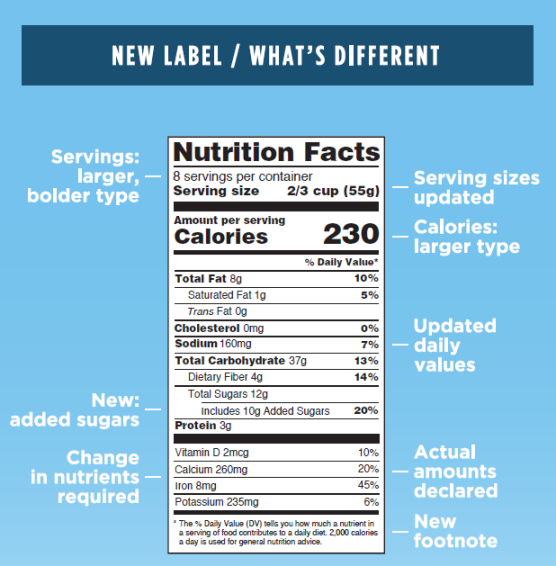Recent changes in the Nutrition Facts label help consumers make better choices
Editor’s note: Although the new U.S. Food & Drug Administration’s Nutrition Facts Label changes were passed in 2016, implementation was delayed until January 1, 2020, for  manufacturers with $10 million or more in annual food sales. Manufacturers with less than $10 million in annual food sales have an extra year to comply—until Jan. 1, 2021. Ecuador has a good food labeling regulations, way ahead of the United States in separating out added sugars, and has a front-of-the-package “semáforo” or “traffic light” labeling panel, signifying if a food is high (red), medium (yellow), or low (green) in added sugars, salt, and fat.
manufacturers with $10 million or more in annual food sales. Manufacturers with less than $10 million in annual food sales have an extra year to comply—until Jan. 1, 2021. Ecuador has a good food labeling regulations, way ahead of the United States in separating out added sugars, and has a front-of-the-package “semáforo” or “traffic light” labeling panel, signifying if a food is high (red), medium (yellow), or low (green) in added sugars, salt, and fat.
By Mark Mahoney
Recent changes to the Nutrition Facts labels on food products are designed to help the consumer make more informed choices. This is of particular importance in times of limited resources such as the present situation with the coronavirus pandemic.
So-called “comfort” foods are generally not the best choices as many of these are contributors to the continuing problem of excess consumption of carbohydrates (carbs), particularly those that are refined. Currently, approximately 50 percent of our calories come from carbs. Added sugars, fruit juice, potatoes, and refined grains contribute about 70 percent of these carbohydrate calories. A much better recipe for consumption would entail consuming whole fruits and grains, legumes, and vegetables.
In a column earlier in the year I had provided a summarized explanation of some of the changes in 2020 to the Nutrition Facts labels with some links for more detailed explanations.
Today’s column comes (largely) from a consumer update from the Food and Drug Administration on how the updated Nutrition Fact Labels can assist you and your family to eat more healthfully during these unprecedented times.
According to Claudine Kavanaugh, Ph.D., MPH, RD, in the U.S. Food and Drug Administration’s Center for Food Safety and Applied Nutrition (CFSAN), “The Nutrition Facts label can help you learn more about the foods you have on hand or are purchasing online or in stores, especially if you are purchasing different foods because of temporary disruptions in the food supply chain or are buying more canned or packaged foods instead of fresh.” Furthermore, she notes that “You can use the information on the label to assist in planning balanced meals and healthy total dietary intakes.”
 Several parts of the Nutrition Facts label have been updated on many foods with others to follow next year. Some of these elements follow:
Several parts of the Nutrition Facts label have been updated on many foods with others to follow next year. Some of these elements follow:
- Calories are now displayed in larger, bolder font.
- Some serving sizes have been updated to better reflect what people actually eat and drink.
- Added sugars, vitamin D and potassium are now listed.
- Daily values have been updated. The Percent Daily Value (%DV) shows how much a nutrient in a serving of food contributes to a total daily diet.
Kavanaugh notes, “You can use the label to help you choose foods that contain more beneficial nutrients and less of those you may want to limit.”
Some general nutrition tips follow for certain nutrients and these have been excerpted from the FDA Consumer update notice:
Calories: Calories refers to the total number of calories, or “energy,” supplied from all sources (carbohydrate, fat, protein and alcohol) in one serving of the food. To achieve or maintain a healthy body weight, you should balance the number of calories you consume with the number of calories your body uses, and balance higher-calorie meals with ones with fewer calories. Two thousand calories a day is used as a general guide for nutrition advice.
Sodium: The Nutrition Facts label shows the amount in milligrams and the % Daily Value of sodium per serving of the food. The Daily Value for sodium is up to 2,300 mg per day. If you want to reduce sodium, look for the words light, low sodium, reduced sodium, or no-salt on packaged foods. You can also flavor foods with herbs and spices and no-salt or low-salt seasoning blends, and rinse sodium-containing canned foods, such as beans, tuna, and vegetables before eating.
Added Sugars: The updated Nutrition Facts label shows the amount in grams and the % Daily Value of added sugars per serving of the food. The Daily Value for added sugars is up to 50 g per day. This is based on a 2,000 calorie daily diet—your Daily Value may be higher or lower depending on your calorie needs.
Dietary Fiber: The Daily Value for dietary fiber is 28 g per day. This is based on a 2,000 calorie daily diet. Your Daily Value may be higher or lower depending on your calorie needs. In addition, look for whole grains on the ingredient list on a food package. Some examples of whole-grain ingredients are barley, brown rice, buckwheat, bulgur, millet, oatmeal, quinoa, rolled oats, whole grain corn, whole grain sorghum, whole oats, whole rye, and whole wheat. Choose whole fruit as snacks and as desserts, when possible. To increase your fiber intake, keep raw, cut-up vegetables handy for quick snacks and try unsalted nuts and seeds in place of some meats and poultry.
By improving our dietary knowledgeable (through a better understanding of the Nutrition Facts label) about the benefits of focusing on consuming a diet rich in vegetables and fruits, with whole-grain consumption, and low saturated fats and sweets, we can improve our chances for a healthier lifestyle and improved quality of life. This will be particularly important both now and as we slowly transition on from the present pandemic.
Resources
Your calorie needs may be higher or lower and vary depending on your age, sex, height, weight and physical activity level. Learn your number and find information on food planning during the coronavirus pandemic at choosemyplate.gov.
For a detailed description of the new Nutrition Facts label with various educational resources please go to the following FDA web link at fda.gov.
Remember to stay up-to-date with information on the COVID-19 pandemic by accessing the Centers for Disease Control and Prevention’s at cdc.gov/coronavirus.
_____________________________

Mark Mahoney, Ph.D., RDN
Credit: The Tallahassee Democrat
Mark A. Mahoney, Ph.D., RDN has been a Registered Dietitian/Nutritionist for over 30 years and completed graduate studies in Nutrition & Public Health at Columbia University. He can be reached at marqos69@hotmail.com.






















